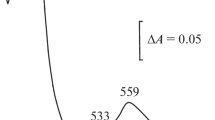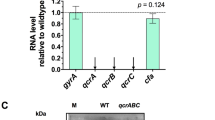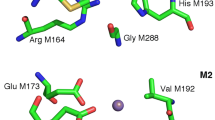Abstract
Manganese(II)-oxidizing bacteria play an integral role in the cycling of Mn as well as other metals and organics. Prior work with Mn(II)-oxidizing bacteria suggested that Mn(II) oxidation involves a multicopper oxidase, but whether this enzyme directly catalyzes Mn(II) oxidation is unknown. For a clearer understanding of Mn(II) oxidation, we have undertaken biochemical studies in the model marine α-proteobacterium, Erythrobacter sp. strain SD21. The optimum pH for Mn(II)-oxidizing activity was 8.0 with a specific activity of 2.5 nmol × min−1 × mg−1 and a K m = 204 μM. The activity was soluble suggesting a cytoplasmic or periplasmic protein. Mn(III) was an intermediate in the oxidation of Mn(II) and likely the primary product of enzymatic oxidation. The activity was stimulated by pyrroloquinoline quinone (PQQ), NAD+, and calcium but not by copper. In addition, PQQ rescued Pseudomonas putida MnB1 non Mn(II)-oxidizing mutants with insertions in the anthranilate synthase gene. The substrate and product of anthranilate synthase are intermediates in various quinone biosyntheses. Partially purified Mn(II) oxidase was enriched in quinones and had a UV/VIS absorption spectrum similar to a known quinone requiring enzyme but not to multicopper oxidases. These studies suggest that quinones may play an integral role in bacterial Mn(II) oxidation.


Similar content being viewed by others
References
Adams LF, Ghiorse WC (1987) Characterization of extracellular Mn2+-oxidizing activity and isolation of an Mn2+-oxidizing protein from Leptothrix discophora SS-1. J Bacteriol 169:1279–1285
Anthony C (1996) Quinoprotein-catalysed reactions. Biochem J 320(Pt 3):697–711
Askwith C et al (1994) The FET3 gene of S. cerevisiae encodes a multicopper oxidase required for ferrous iron uptake. Cell 76:403–410
Barnett RE (1970) Effect of monovalent cations on the ouabain inhibition of the sodium and potassium ion activated adenosine triphosphatase. Biochemistry 9:4644–4648
Boogerd FC, de Vrind JP (1987) Manganese oxidation by Leptothrix discophora. J Bacteriol 169:489–494
Bradford MM (1976) A rapid and sensitive method for the quantitation of microgram quantities of protein utilizing the principle of protein-dye binding. Anal Biochem 72:248–254
Brouwers G, de Vrind JPM, Corstjens PLAM, Cornelis P, Baysse C, de Vrind-de Jong EW (1999) cumA, a gene encoding a multicopper oxidase, is involved in Mn2+ oxidation in Pseudomonas putida GB-1. Appl Environ Microbiol 65:1762–1768
Brouwers GJ, Corstjens PLAM, de Vrind JPM, Verkamman A, de Kuyper M, de Vrind-de Jong EW (2000a) Stimulation of Mn2+ oxidation in Leptothrix discophora SS-1 by Cu2+ and sequence analysis of the region flanking the gene encoding putative multicopper oxidase MofA. Geomicrobiol J 17:25–33
Brouwers GJ, Vijgenboom E, Corstjens PLAM, De Vrind JPM, de Vrind-de Jong EW (2000b) Bacterial Mn2 + oxidizing systems and multicopper oxidases: an overview of mechanisms and functions. Geomicrobiol J 17:1–24
Caspi R, Tebo BM, Haygood MG (1998) c-type cytochromes and manganese oxidation in Pseudomonas putida MnB1. Appl Environ Microbiol 64:3549–3555
Cheung M, Klimov D, Thirumalai D (2005) Molecular crowding enhances native state stability and refolding rates of globular proteins. Proc Natl Acad Sci 102:4753–4758
Cobley JG, Haddock BA (1975) The respiratory chain of Thiobacillus ferrooxidans: the reduction of cytochromes by Fe2 + and the preliminary characterization of rusticyanin a novel “blue” copper protein. FEBS Lett 60:29–33
Corstjens PLAM, De Vrind JPM (1997) Identification and molecular analysis of the Leptothrix discophora SS-1mofA gene, a gene putatively encoding a manganese-oxidizing protein with copper domains. Geomicrobiol J 14:91–108
Cox JC, Boxer DH (1978) The purification and some properties of rusticyanin, a blue copper protein involved in iron(II) oxidation from Thiobacillus ferro-oxidans. Biochem J 174:497–502
Dooley DM, McGuirl MA, Peisach J, McCracken J (1987) The generation of an organic free radical in substrate-reduced pig kidney diamine oxidase-cyanide. FEBS Lett 214:274–278
Duine JA (1991) Quinoproteins: enzymes containing the quinonoid cofactor pyrroloquinoline quinone, topaquinone or tryptophan–tryptophan quinone. Eur J Biochem 200:271–284
Fluckiger R, Paz M, Mah J, Bishop A, Gallop PM (1993) Characterization of the glycine-dependent redox-cycling activity in animal fluids and tissues using specific inhibitors and activators: evidence for presence of PQQ. Biochem Biophys Res Commun 196:61–68
Fluckiger R, Paz MA, Gallop PM (1995) Redox-cycling detection of dialyzable pyrroloquinoline quinone and quinoproteins. Methods Enzymol 258:140–149
Francis CA, Co E, Tebo BM (2001) Enzymatic manganese(II) oxidation by a marine α-proteobacterium. Appl Environ Microbiol 67:4024–4029
Francis CA, Casciotti KL, Tebo BM (2002) Localization of Mn(II)-oxidizing activity and the putative multicopper oxidase, MnxG, to the exosporium of the marine Bacillus sp. strain SG-1. Arch Microbiol 178:450–456
Frank J Jr, Dijkstra M, Duine JA, Balny C (1988) Kinetic and spectral studies on the redox forms of methanol dehydrogenase from Hyphomicrobium X. Eur J Biochem 174:331–338
Fukumori Y, Yano T, Sato A, Yamanaka T (1988) Fe(II)-oxidizing enzyme purified from Thiobacillus ferrooxidans. FEMS Microbiol Lett 50:169–172
Garfin DE (1990) One-dimensional gel-electrophoresis. Methods Enzymol 182:425–441
Goericke R (2002) Bacteriochlorophyll a in the ocean: is anoxygenic bacterial photosynthesis important? Limnol Oceanogr 47:290–295
Guillen F, Martinez MJ, Munoz C, Martinez AT (1997) Quinone redox cycling in the ligninolytic fungus Pleurotus eryngii leading to extracellular production of superoxide anion radical. Arch Biochem Biophys 339:190–199
Harrison PM, Arosio P (1996) The ferritins: molecular properties, iron storage function and cellular regulation. Biochim Biophys Acta 1275:161–203
Hille R (1994) The reaction mechanism of oxomolybdenum enzymes. Biochim Biophys Acta 1184:143–169
Hofer C, Schlosser D (1999) Novel enzymatic oxidation of Mn2+ to Mn3+ catalyzed by a fungal laccase. FEBS Lett 451:186–190
Huston WM, Jennings MP, McEwan AG (2002) The multicopper oxidase of Pseudomonas aeruginosa is a ferroxidase with a central role in iron acquisition. Mol Microbiol 45:1741–1750
Kim C, Lorenz WW, Hoopes JT, Dean JFD (2001) Oxidation of phenolate siderophores by the multicopper oxidase encoded by the Escherichia coli yacK gene. J Bacteriol 183:4866–4875
Kobayashi A et al (2005) Transition metal complexes coordinated by an NAD(P)H model compound and their enhanced hydride-donating abilities in the presence of a base. Chemistry 11:4219–4226
Kolber ZS et al (2001) Contribution of aerobic photoheterotrophic bacteria to the carbon cycle in the ocean. Science 292:2492–2495
Larsen EI, Sly LI, McEwan AG (1999) Manganese(II) adsorption and oxidation by whole cells and a membrane fraction of Pedomicrobium sp. ACM 3067. Arch Microbiol 171:257–264
Lindley PF et al (1997) An X-ray structural study of human ceruloplasmin in relation to ferroxidase activity. J Biol Inorg Chem 2:454–463
van der Meer RA, Jongejan JA, Duine JA (1987) Phenylhydrazine as probe for cofactor identification in amine oxidoreductases. FEBS Lett 221:299–304
van der Meer RA, Groen BW, van Kleef MA, Frank J, Jongejan JA, Duine JA (1990) Isolation, preparation, and assay of pyrroloquinoline quinone. Methods Enzymol 188:260–283
Michal G (ed) (1998) Biochemical pathways, 3rd edn. Boehringer, Mannheim
Mordasini T, Curioni A, Andreoni W (2003) Why do divalent metal ions either promote or inhibit enzymatic reactions? The case of BamHI restriction endonuclease from combined quantum-classical simulations. J Biol Chem 278:4381–4384
Murray KJ, Tebo BM (2007) Cr(III) is indirectly oxidized by the Mn(II)-oxidizing bacterium Bacillus sp. strain SG-1. Environ Sci Technol 41:528–533
Musci G, Di Marco S, Bellenchi GC, Calabrese L (1996) Reconstitution of ceruloplasmin by the Cu(I)–glutathione complex. Evidence for a role of Mg2+ and ATP. J Biol Chem 271:1972–1978
Okazaki M et al (1997) Partial purification and characterization of manganese-oxidizing factors of Pseudomonas fluorescens GB-1. Appl Environ Microbiol 63:4793–4799
Oubrie A, Rozeboom HJ, Dijkstra BW (1999) Active-site structure of the soluble quinoprotein glucose dehydrogenase complexed with methylhydrazine: a covalent cofactor-inhibitor complex. Proc Natl Acad Sci USA 96:11787–11791
Ridge JP, Lin M, Larsen EI, Fegan M, McEwan AG, Sly LI (2007) A multicopper oxidase is essential for manganese oxidation and laccase-like activity in Pedomicrobium sp. ACM 3067. Environ Microbiol 9:944–953
Sato A, Takagi K, Kano K, Kato N, Duine JA, Ikeda T (2001) Ca2+ stabilizes the semiquinone radical of pyrroloquinoline quinone. Biochem J 357:893–898
Schlosser D, Hofer C (2002) Laccase-catalyzed oxidation of Mn2+ in the presence of natural Mn3+ chelators as a novel source of extracellular H2O2 production and its impact on manganese peroxidase. Appl Environ Microbiol 68:3514–3521
Solano F, Lucas-Elio P, Lopez-Serrano D, Fernandez E, Sanchez-Amat A (2001) Dimethoxyphenol oxidase activity of different microbial blue multicopper proteins. FEMS Microbiol Lett 204:175–181
Solomon EI, Sundaram UM, Machonkin TE (1996) Multicopper oxidases and oxygenases. Chem Rev 96:2563–2605
Stams AJM, Kremer DR, Nicolay K, Weenk GH, Hansen TA (1984) Pathway of propionate formation in Desulfobulbus propionicus. Arch Microbiol 139:167–173
Stoj C, Kosman DJ (2003) Cuprous oxidase activity of yeast Fet3p and human ceruloplasmin: implication for function. FEBS Lett 554:422–426
Supuran CT, Vullo D, Manole G, Casini A, Scozzafava A (2004) Designing of novel carbonic anhydrase inhibitors and activators. Curr Med Chem Cardiovasc Hematol Agents 2:51–70
Tebo BM et al (2004) Biogenic manganese oxides: properties and mechanisms of formation. Annu Rev Earth Planet Sci 32:287–328
Tebo BM, Johnson HA, McCarthy JK, Templeton AS (2005) Geomicrobiology of manganese(II) oxidation. Trends Microbiol 13:421–428
van Waasbergen LG, Hoch JA, Tebo BM (1993) Genetic analysis of the marine manganese-oxidizing Bacillus sp. strain SG-1: protoplast transformation, Tn917 mutagenesis, and identification of chromosomal loci involved in manganese oxidation. J Bacteriol 175:7594–7603
van Waasbergen LG, Hildebrand M, Tebo BM (1996) Identification and characterization of a gene cluster involved in manganese oxidation by spores of the marine Bacillus sp. strain SG-1. J Bacteriol 178:3517–3530
Webb S, Bargar J, Dick GJ, Johnson HA, McCarthy JK, Tebo BM (2004) Insights into the mechanism of enzymatic manganese(II) oxidation by diverse bacterial species. Am Chem Soc (Abstract papers)
Webb SM, Dick GJ, Bargar JR, Tebo BM (2005) Evidence for the presence of Mn(III) intermediates in the bacterial oxidation of Mn(II). Proc Natl Acad Sci 102:5558–5563
Zaitsev VN, Zaitseva I, Papiz M, Lindley PF (1999) An X-ray crystallographic study of the binding sites of the azide inhibitor and organic substrates to ceruloplasmin, a multi copper oxidase in the plasma. J Biol Inorg Chem 4:579–587
Zhang JH, Lion LW, Nelson YM, Shuler ML, Ghiorse WC (2002) Kinetics of Mn(II) oxidation by Leptothrix discophora SS1. Geochim Et Cosmochim Acta 66:773–781
Acknowledgments
We thank Cassandra Gaston, Patrizia Pretto, James McCarthy, and Greg Dick for laboratory assistance and helpful discussions. We thank Hans Duine for generously supplying soluble glucose dehydrogenase apoenzyme. We thank the Gordon and Betty Moore Foundation and The Venter Institute for Genome Sequencing of Erythrobacter sp. SD21. This research was funded by grants from the National Science Foundation (CHE-0089208 and MCB-0630355) and a Superfund Basic Research Program Grant to UCSD (NIEHS ES10337).
Author information
Authors and Affiliations
Corresponding author
Additional information
Communicated by Friedrich Widdel.
Rights and permissions
About this article
Cite this article
Johnson, H.A., Tebo, B.M. In vitro studies indicate a quinone is involved in bacterial Mn(II) oxidation. Arch Microbiol 189, 59–69 (2008). https://doi.org/10.1007/s00203-007-0293-y
Received:
Revised:
Accepted:
Published:
Issue Date:
DOI: https://doi.org/10.1007/s00203-007-0293-y




